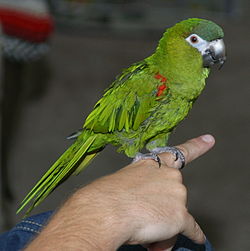
Mini-macaws are a loosely defined group of small-to-medium-sized macaw species within the tribe Arini. The term has no fixed taxonomic meaning and is principally used in aviculture to describe a small macaw belonging to one of a number of different genera, with overall length being the sole criterion for inclusion. Any macaw with an overall length (including the tail) of less than about 50 cm (20 inches) can be described as a "mini-macaw". Additionally, the "mini-" prefix may be added to the species name when describing the bird in question (e.g. "red-shouldered mini-macaw").[ citation needed ] Mini-macaws have predominantly green plumage with various accenting colours. [1]
Contents
Mini-macaws are explicitly demarcated from large macaws in the Portuguese language by the term "maracanã", as opposed to "arara".
In the pet trade, the term can be used to suggest that the species in question is better suited as a companion parrot for owners with less space in their homes than would be required by one of the larger macaw species, [2] [ unreliable source? ] [3] and may be easier to train than larger macaws. [1] However, most mini-macaws (aside from the red-shouldered macaw, which is parakeet sized) are still fairly large parrots and only "mini" in comparison to their larger relatives.